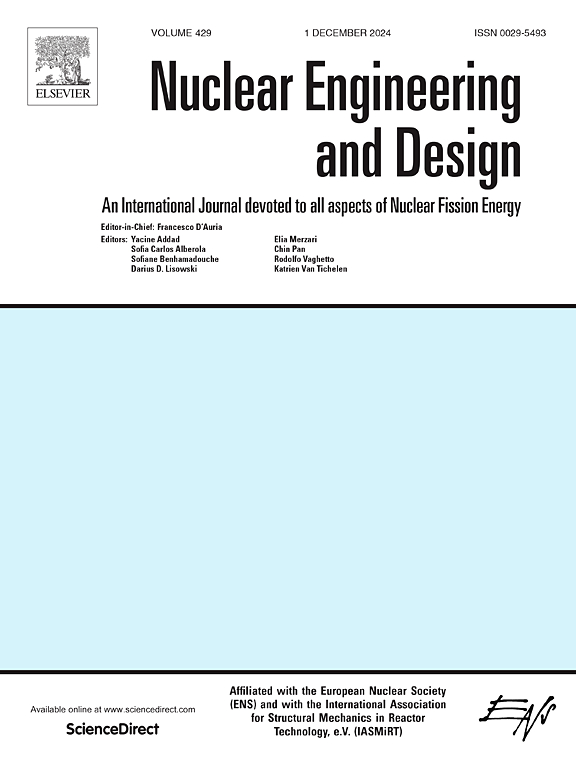中低放射性废物封存用胶凝砂浆:基质优化与浸出
IF 2.1
3区 工程技术
Q1 NUCLEAR SCIENCE & TECHNOLOGY
引用次数: 0
摘要
利用火山灰水泥(CEM IV/A 42.5 R型符合欧洲标准EN 197-1)制备的水泥基砂浆在不使用昂贵添加剂的情况下,优化了中、低放射性废物的密封。替代放射性核素,包括锂(Li)、铯(Cs)、钴(Co)和铅(Pb)盐,被纳入模拟真实的废物流。实验重点优化了砂浆的水灰比、砂灰比,并评估了模拟核素添加对其性能的影响。在所研究的放射性核素添加水平(2.5 mmol/kg)下,砂浆的抗压强度保持在约54 N/mm2,而吸水率和和易性相对于参考值保持不变。然而,热重分析和傅里叶变换红外光谱分析表明,放射性核素干扰了水化反应。硬化单体试样的浸出试验显示出不同的放射性核素迁移率,顺序如下:Cs祝辞公司在Pb。在所有情况下,浸出指数均大于8,证实有效遏制。除Pb外,扩散是所有模拟放射性核素的控制机制,其释放过程以冲刷为主。这些结果证实了CEM IV/A基砂浆是一种有效的固定放射性核素的材料,在保持机械完整性的同时限制了放射性核素的迁移。本文章由计算机程序翻译,如有差异,请以英文原文为准。
Cementitious mortar for Intermediate and Low-Level Radioactive waste confinement: Matrix optimization and leaching
A cement-based mortar prepared utilizing a pozzolanic cement (CEM IV/A 42.5 R type conforming to European Standard EN 197–1) was optimized for the containment of Intermediate and Low-Level Radioactive Waste without the use of expensive additives. Surrogate radionuclides, including lithium (Li), cesium (Cs), cobalt (Co), and lead (Pb) salts, were incorporated to simulate real waste streams.
The experiments focused on optimizing the water-to-cement ratio, the sand-to-cement ratio of the mortar, and assessing the effects of simulated radionuclide addition on its properties. At the investigated level of adding radionuclides (2.5 mmol/kg), the mortar maintained a compressive strength of approximately 54 N/mm2, while water absorption and workability remained unchanged with respect to the reference. However, thermogravimetric analysis and Fourier-transform infrared spectroscopy indicated that radionuclides interfered with the hydration reaction.
Leaching tests on hardened monolith specimens demonstrated varying radionuclide mobilities, with the following order: Li > Cs > Co > Pb. In all cases, the leachability index was greater than 8, confirming effective containment. Diffusion was identified as the controlling mechanism for all simulated radionuclides except Pb, for which wash-off dominated the release process. These results confirm that CEM IV/A based mortar is an effective material for immobilizing radionuclides, maintaining mechanical integrity while limiting radionuclide migration.
求助全文
通过发布文献求助,成功后即可免费获取论文全文。
去求助
来源期刊

Nuclear Engineering and Design
工程技术-核科学技术
CiteScore
3.40
自引率
11.80%
发文量
377
审稿时长
5 months
期刊介绍:
Nuclear Engineering and Design covers the wide range of disciplines involved in the engineering, design, safety and construction of nuclear fission reactors. The Editors welcome papers both on applied and innovative aspects and developments in nuclear science and technology.
Fundamentals of Reactor Design include:
• Thermal-Hydraulics and Core Physics
• Safety Analysis, Risk Assessment (PSA)
• Structural and Mechanical Engineering
• Materials Science
• Fuel Behavior and Design
• Structural Plant Design
• Engineering of Reactor Components
• Experiments
Aspects beyond fundamentals of Reactor Design covered:
• Accident Mitigation Measures
• Reactor Control Systems
• Licensing Issues
• Safeguard Engineering
• Economy of Plants
• Reprocessing / Waste Disposal
• Applications of Nuclear Energy
• Maintenance
• Decommissioning
Papers on new reactor ideas and developments (Generation IV reactors) such as inherently safe modular HTRs, High Performance LWRs/HWRs and LMFBs/GFR will be considered; Actinide Burners, Accelerator Driven Systems, Energy Amplifiers and other special designs of power and research reactors and their applications are also encouraged.
 求助内容:
求助内容: 应助结果提醒方式:
应助结果提醒方式:


